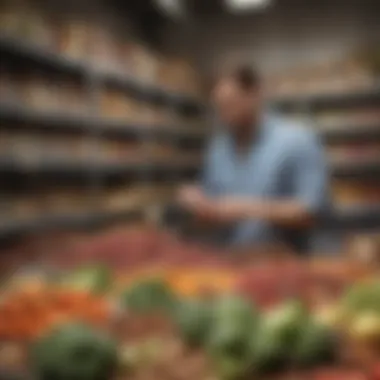Food for Patriots: The Three-Month Supply Explained


Intro
In recent years, the importance of having a reliable food supply for emergencies has gained significant attention. Preparing for unforeseen events, whether natural disasters or economic uncertainties, has become a critical focus for many individuals and families. This preparation often revolves around a three-month supply of food. Understanding this concept requires an in-depth examination of not only what such a supply includes but also its potential benefits and implications.
A three-month food supply offers a buffer against most situations where access to food may be compromised. Whether due to economic challenges, disruptions to food distribution networks, or emergency conditions, having enough food to last for three months can provide peace of mind. It enables individuals to rely less on grocery stores, which may not be accessible in times of crisis.
This article will discuss the essential components of a three-month food supply, focusing on nutritional balance, sourcing options, and preservation methods. It will also address practical considerations for creating and maintaining a stockpile. The goal is to equip readers with knowledge that promotes self-sufficiency and resilience.
Having a diverse selection of foods is crucial, not merely for sustenance but to ensure nutrition and morale. Foods included should cover the essential macronutrients of proteins, carbohydrates, and fats, as well as vitamins and minerals. Ensuring variety is key to maintaining interest in the food supply during prolonged periods.
As we delve deeper into this topic, we will explore guiding principles that inform effective food sourcing, methods of preservation that maximize shelf life, and strategies that allow families to cultivate their own stock. Through careful planning and informed choices, anyone can navigate the landscape of emergency preparedness with confidence.
Prolusion to Food for Patriots
Understanding the concept of providing a stable, reliable food supply for those who consider themselves patriots is essential in today’s uncertain times. The idea of having a three-month supply is not just about hoarding food; it reflects a commitment to self-sufficiency and preparedness. This section explores why a three-month food stock is beneficial, especially for individuals and families who aim to take charge of their own resources in case of emergencies.
A three-month food supply can offer peace of mind. It ensures that you are ready for unexpected situations, such as natural disasters or economic downturns. However, the benefits extend beyond mere survival. This proactive approach enables individuals to maintain their routines without significant disruptions. Preparing a food stock can foster a feeling of security and independence.
In understanding Food for Patriots, important considerations are related to the quality and types of food selected. Factors like nutritional value, storage conditions, and sourcing also come into play. This article will elucidate such elements, offering valuable insights into achieving a successful food supply for any patriot.
Defining Emergency Preparedness
Emergency preparedness is a critical aspect of personal and community resilience. It encompasses a wide array of strategies designed to equip individuals and families to effectively handle potential crises. The concept is not merely about having a three-month food supply, but rather includes planning, resources, and knowledge. By defining emergency preparedness, we can identify the role various elements play in securing our well-being during unpredictable situations.
Preparedness begins with an understanding of risks. A clear assessment allows individuals to determine what emergencies could impact their lives, from natural disasters to economic downturns. Each scenario demands a tailored approach, ensuring that the specific needs of a household are met. This proactive mindset can significantly mitigate the impacts of a disaster, providing peace of mind during chaotic times.
Incorporating food supplies into preparedness plans serves multiple functions. It provides immediate sustenance, reduces anxiety about food scarcity, and allows people to focus on other critical tasks during emergencies. Furthermore, having an adequate food supply can enable families to assist neighbors, fostering community resilience. Understanding the importance of food in preparedness plans deepens our commitment to self-sufficiency, thus enhancing our general preparedness strategy.
The Role of Food in Preparedness Plans
In any emergency scenario, food is a fundamental need. It sustains us physically and mentally. Therefore, planning for sufficient food supplies is essential. Depending on individual dietary restrictions and preferences, the type of food stored should be diverse yet practical.
When putting together food supplies for emergencies, consider the following elements:
- Shelf Life: Select non-perishable items that can withstand the test of time.
- Nutritional Value: Incorporate a balance of carbohydrates, proteins, and essential vitamins.
- Water Supply: Remember to account for water, as food preparation often requires hydration.
Overall, food serves as a buffer against uncertainty and should be central in all preparedness plans.
Types of Emergencies to Consider
When preparing for emergencies, it is crucial to evaluate various potential scenarios one might encounter. These include:
- Natural Disasters: Events like hurricanes, earthquakes, or floods can disrupt normal life.
- Economic Crisis: Sudden shifts in the job market may affect food access.
- Pandemics: Health crises can create prolonged periods of isolation, making it difficult to shop for food.
- Civil Unrest: Social instability may lead to disruptions in supply chains.
Each type of emergency has unique implications for food storage and management. Provisions should be adaptable, capable of meeting differing needs while ensuring sustainability.
Components of a Three-Month Food Supply


Understanding the components of a three-month food supply is essential for effective preparedness. This section delves into the various food categories that form the foundation of a stockpile, ensuring nutritional adequacy and versatility. Each component plays a crucial role in meeting dietary needs during challenging situations, assisting in maintaining overall health and well-being. A well-rounded food supply considers not only the caloric requirements but also the macro and micronutrients necessary for sustaining energy levels and functioning optimally.
Essential Food Categories
Grains and Cereals
Grains and cereals are vital staples in any food supply. Their primary contribution lies in providing carbohydrates, which serve as the main energy source for the body. Common grains include rice, oats, and wheat. One key characteristic of grains is their long shelf life, making them a practical choice for stockpiling. In addition, grains can often be processed into various forms such as flour or pasta, which adds to the versatility of meals prepared from them.
However, it is important to note that grains alone do not provide sufficient nutrients. They should be complemented with other food categories to ensure a balanced diet.
Canned Goods
Canned goods are another cornerstone of a three-month supply. These foods offer the advantage of extended shelf life and convenience. Items like beans, vegetables, and meats packed in cans require no refrigeration until opened, making them a reliable choice for stockpiling. Their ready-to-eat nature can be invaluable in emergency situations when cooking options may be limited. However, attention should be given to sodium levels in canned foods, as excessive salt can be a concern for health, particularly for those with dietary restrictions.
Freeze-Dried Foods
Freeze-dried foods have gained popularity in preparedness planning. Their unique preservation technique removes moisture, allowing foods to maintain flavor and nutrient density for years. This method retains not only the texture and taste but also minimizes the growth of bacteria, offering a safe option for long-term storage. Freeze-dried meals can be reconstituted with water, making them easy to prepare. However, they can be more expensive than other items, potentially limiting their feasibility as a primary food source.
Nutrition Supplements
Nutrition supplements may serve as an adjunct to a three-month food supply. They typically come in the form of powders, pills, or fortified foods. These products can bridge nutrient gaps that may arise from a limited diet. For instance, vitamins and minerals ensure that essential nutrients are not missed, particularly when fresh foods are unavailable. The advantage of using supplements is the assurance of receiving needed nutrients in a practical format. Nonetheless, reliance solely on supplements can lead to an imbalanced diet; they should complement a diverse food supply rather than replace whole foods.
Nutritional Balance and Variety
Ensuring nutritional balance and variety is critical in maintaining health during emergencies. A diverse food supply supports various dietary needs, accommodating different preferences and restrictions. It is necessary to include protein sources, healthy fats, vitamins, and minerals to meet all dietary requirements. Practicing mindful selection of food categories ensures that sustenance during emergencies supports both physical and mental resilience. Regular reassessment of the food stock is vital, allowing individuals to rotate items and consume those nearing expiration while also adapting the supply to changing needs.
Sourcing Your Food Supply
Sourcing your food supply is a crucial aspect of maintaining a robust three-month stockpile. This process involves understanding where your food comes from and ensuring that it meets quality standards, nutritional needs, and ethical considerations. Selecting the right sourcing methods can impact not only the freshness and quality of your supplies but also align with your personal values regarding food production and consumption.
When discussing sourcing, it is essential to consider both local and online options. Each has its advantages and challenges that can affect choices made by individuals wanting to build their emergency food reserves.
Local vs. Online Options
Local sourcing can provide several benefits. It often involves purchasing from farmer's markets or local suppliers. This approach allows you to obtain fresh produce, grains, and other goods with minimal travel distance. You can often inquire directly about farming practices and the growing conditions of the food. Supporting local farmers also strengthens community ties and reduces the carbon footprint associated with transportation.
On the flip side, online sourcing offers convenience and typically a wider selection of shelf-stable food options. Many companies specialize in emergency food supplies and provide detailed information on long-term storage. Online shopping enables buyers to compare prices and find specific brands that meet their dietary needs.
However, one must consider potential shipping delays that could arise in times of crisis. This unpredictability can jeopardize your supplies when quick access is necessary.
Ethical Sourcing Practices
Ethical sourcing involves choosing food suppliers that adhere to humane and sustainable practices. This includes supporting farms that utilize organic farming methods, avoid using harmful pesticides, and provide fair wages to workers. It is increasingly important to consider the broader impacts of food sourcing.[^1]
Here are some factors to think about regarding ethical sourcing:
- Transparency: Look for information about how and where the food is produced.
- Sustainability: Choose suppliers that prioritize renewable resources and minimize ecological damage.
- Animal welfare: Select products that come from farms adhering to humane treatment standards.
Establishing an ethical food supply does contribute to a sense of responsibility and can inspire others to consider their choices as well. People can align their stockpiling efforts with their values, which enhances personal fulfillment and can create a more sustainable food system overall.
Ethical sourcing isn’t just about quantity; it’s also about quality, values, and community impact.


Researching and connecting with various sources can lead to an informed choice in both local and online purchasing. This foundational understanding of sourcing food will ensure a well-rounded three-month food supply that reflects personal commitments to nutrition and ethical practices.
[^1]: For further reading on ethical sourcing, see the Wikipedia article on Sustainable Food.
Preservation Techniques
Preservation techniques play a crucial role in ensuring that a three-month food supply remains safe, nutritious, and good to eat. Without proper preservation, food can spoil quickly, losing its value and reliability when needed. Employing various preservation methods not only maximizes the shelf life of food but also helps maintain its nutritional content. Here, we will explore two primary methods: canning and bottling, along with freezing and dehydration. Each method has its benefits, considerations, and applications.
Canning and Bottling
Canning and bottling are traditional preservation techniques that can significantly extend the shelf life of foods. This method involves sealing food in airtight jars or cans, which are then heated to destroy harmful bacteria. This process ensures that the contents remain safe for consumption over extended periods.
Benefits of canning include:
- Long Shelf Life: Properly canned food can last for years without refrigeration.
- Nutrient Retention: The heating process preserves essential vitamins and minerals, making it a healthy choice.
- Variety: Almost any fruit, vegetable, or meat can be canned, enabling a diverse food supply.
However, there are considerations to bear in mind:
- Equipment Needs: Canning requires specific tools like jars, lids, and a pressure cooker or water bath canner.
- Safety Protocols: It is essential to follow guidelines strictly to avoid contamination or spoilage. Improper canning can lead to serious health risks, including botulism.
Freezing and Dehydration
Freezing and dehydration are effective methods to preserve food while ensuring maximum freshness. Freezing slows down enzyme activity that can cause food to spoil. It retains the food's color, texture, and flavor. Generally, most foods fare well in the freezer, as long as they are stored in suitable containers.
Benefits of freezing include:
- Ease of Use: Many foods can be frozen without special techniques. Just freeze at appropriate temperatures.
- Retained Nutrients: Freezing generally preserves food more effectively than other methods when it comes to nutrient preservation.
On the other hand, dehydration removes moisture from food, which prevents the growth of bacteria and molds. This method is great for foods like fruits, vegetables, and meats.
Key advantages of dehydration:
- Lightweight and Compact: Dehydrated foods are easy to store and transport.
- Long-Lasting: Dried foods can last several months to years if stored properly.
Considerations when using freezing and dehydration:
- Storage Space: Freezers require power and ample space, while dehydrated foods need airtight containers.
- Pre-Treatment: Some foods require blanching or other pre-treatments before freezing to ensure quality.
"Utilizing preservation techniques is not just about keeping food; it’s about optimizing your dietary resources for emergencies and beyond."
In summary, both canning and bottling, as well as freezing and dehydration, are invaluable methods for extending the life of your food supply. Understanding how to implement these techniques effectively is vital for anyone looking to prepare for emergencies or stockpile food efficiently. Integrating these methods into your food storage strategy can lead to a more resilient and self-sufficient lifestyle.
Practical Considerations for Stockpiling
When embarking on the journey of creating a three-month food supply, understanding practical considerations is crucial. This aspect ensures that the stockpiling process is effective, sustainable, and aligned with the specific needs of individuals or families. Practical considerations include the adequacy of storage space, the environmental conditions affecting food longevity, and strategies for maintaining an organized inventory.
Storage Space and Conditions


Adequate storage space is a fundamental element in stockpiling food. Without the right space, even the best-prepared plans may fail. It's essential to first assess the available areas in your home, such as pantries, basements, or garage spaces. These spaces need to be cool, dark, and dry to maintain the quality of food supplies. Here are a few tips on establishing effective storage:
- Choose the correct location: Avoid areas with high humidity or temperature fluctuations.
- Use airtight containers: To prevent moisture and pests from damaging your stockpile, opt for airtight bins or vacuum-sealed bags.
- Label everything: Clear labeling helps in knowing what items you have, their expiration dates, and their state, allowing for easier organization and access.
Moreover, ensuring proper ventilation in the storage area can contribute to maintaining ideal conditions. Elevated temperature and humidity can shorten the shelf life of many food items.
Inventory Management Strategies
Once you have established your storage, the next step is effective inventory management. Keeping track of your food supplies is vital to ensure that nothing goes to waste and that your stock remains practical for any emergency. Here are some strategies for efficient inventory management:
- Create an inventory list: Maintain a document (digital or physical) that lists all items in your stockpile along with their quantities and expiration dates.
- Use the FIFO method: First In, First Out is a system where older items are used before newer ones, preventing spoilage.
- Regularly check your stock: Conduct routine checks to refresh your inventory list and identify any items that may need to be replaced.
- Be mindful of dietary needs: Customize your inventory according to individual or family dietary restrictions to ensure all members have access to suitable food.
Keeping a vigilant eye on inventory can greatly enhance your preparedness, ensuring that your three-month food supply remains relevant and usable.
By paying attention to these practical considerations, you can develop a robust stockpile that meets your needs while being sustainable over time.
Sustainable Practices in Food Supply Management
Sustainable practices in food supply management are crucial, especially when considering the long-term efficiency and responsibility of maintaining a three-month food supply. These practices not only assure the durability of one's stockpile but also contribute positively to the environment and society. With the increasing pressures on global food systems, integrating sustainable methods becomes imperative. The key areas to focus on include minimizing waste and adopting permaculture principles.
Minimizing Waste
Waste reduction plays a significant role in the sustainability of food supplies. When preparing for emergencies, it is essential to use a systematic approach to ensure that all food items are utilized efficiently. Here are some strategies to minimize waste:
- Expiration Date Awareness: Regularly check expiration dates and rotate supplies. Knowing which items will expire soon helps in planning meals accordingly.
- Proper Storage Techniques: Utilize airtight containers, humidity packs, and cool, dark storage locations to extend the life of food.
- Creative Cooking: Use scraps and leftovers in new recipes, making full use of your resources. For instance, vegetable peels can be used for broth instead of being discarded.
The benefits of these practices extend beyond personal consumption. They contribute to reducing the burden on landfills and decrease the overall carbon footprint associated with food production.
Integrating Permaculture Principles
Permaculture principles offer a holistic approach to food supply management, focusing on ecological harmony and sustainable resource use. Integrating these principles can lead to improved resilience in food supplies. Some core aspects of permaculture to consider include:
- Diversity: Planting a variety of crops can reduce reliance on any single food source, increasing resilience against pests and diseases. This ensures that if one crop fails, others can still provide sustenance.
- Natural Resources: Utilizing local resources wisely, such as rainwater harvesting and composting organic waste, helps to create a self-sufficient ecosystem that nourishes food growth.
- Community Involvement: Engaging with local communities fosters knowledge exchange and support systems around food production and storage. This can lead to better practices and shared resources.
"Sustainable practices not only support longevity but also cultivate awareness about our impact on the planet."
By embracing sustainable practices in food supply management, you ensure that your supply is effective in emergencies while also promoting a healthier environment and community. Implementing these methods aligns with broader goals of self-sufficiency and resilience, ultimately enriching individual experiences and collective futures.
Closure
The conclusion serves as a critical component in encapsulating the essence of maintaining a three-month food supply for patriots. It reflects on the overarching themes of preparedness, self-sufficiency, and the practical steps one needs to embrace. A well-stocked food supply is more than mere convenience; it embodies a proactive approach to unforeseen challenges and emphasizes the importance of resilience in today’s unpredictable world.
Reflecting on Preparedness and Self-Sufficiency
Preparedness extends beyond simply having food on hand. It involves cultivating a mindset geared towards self-sufficiency. Understanding the nutritional requirements of one�’s family and ensuring a balanced diet is key. A diverse food supply offers not only sustenance but also emotional security. In times of crisis, knowing that essential dietary needs are met can alleviate stress. Reflecting on preparedness, it’s essential to create plans that encompass range and variety in food choices. This approach fosters confidence and provides assurance that one can weather any storm.
Some points to consider include:
- Assessing individual needs: Understanding dietary restrictions or preferences within the family.
- Diverse food inventory: Including different categories such as grains, proteins, and seasonal vegetables.
- Regular rotation practices: To keep food supplies fresh and usable, ensuring no waste and continuous sustainability.
Continuous Learning and Adaptation
Continuous learning is vital for anyone engaged in food preparation and emergency planning. Conditions change, as do available resources and methods of preservation. Keeping abreast of new techniques, suppliers, and nutritional research is essential.
Adapting to new information enhances one’s capability to manage a food supply effectively. For example, engaging with communities on platforms like Reddit can provide insights into recent trends in food preservation or sourcing. Joining groups centered on preparedness can facilitate knowledge sharing and emotional support.







